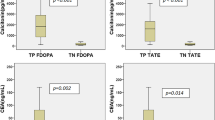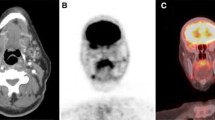Abstract
Purpose
The aim of this study was to prospectively compare the detection rate of 68Ga-DOTATATE PET-CT with 111In-octreotide SPECT-CT and conventional imaging (CI) in medullary thyroid carcinoma (MTC) patients with increased calcitonin (Ctn) levels but negative CI after thyroidectomy.
Methods
Fifteen patients with raised Ctn levels and/or CI evidence of recurrence underwent 68Ga-DOTATATE PET-CT, 111In-octreotide SPECT-CT and CI. Histopathology, CI and biochemical/clinical/imaging follow-up were used as the reference standard. PET/CT, SPECT/CT and CI were compared in a lesion-based and organ-based analysis.
Results
PET/CT evidenced recurrence in 14 of 15 patients. There were 13 true positive (TP), 1 true negative (TN), 1 false positive (FP) and no false negative (FN) cases, resulting in a sensitivity and accuracy of 100% and 93%. SPECT/CT was positive in 6 of 15 cases. There were 6 TP, 2 TN, 7 FN and no FP cases, resulting in a sensitivity of 46% and accuracy of 53%. CI procedures detected tumor lesions in 14 of 15 patients. There were 13 TP, 1TN, 1 FP and no FN cases with a sensitivity of 100% and accuracy of 93%.
A significantly higher number of lesions was detected by PET/CT (112 lesions, p = 0.005) and CI (109 lesions, p = 0.005) in comparison to SPECT/CT (16 lesions). There was no significant difference between PET/CT and CI for the total number of detected lesions (p = 0.734). PET/CT detected more lesions than SPECT/CT regardless of the organ. PET/CT detected more bone lesions but missed some neck nodal metastases evidenced by CI. The number of lesions per region demonstrated by PET/CT and CI were similar in the other sites.
Conclusion
68Ga-DOTATATE PET/CT is superior to 111In-octreotide SPECT/CT for the detection of recurrent MTC demonstrating a significantly higher number of lesions. 68Ga-DOTATATE PET/CT showed a superior detection rate compared to CI in demonstrating bone metastases.

Similar content being viewed by others
References
Kebebew E, Ituarte PH, Siperstein AE, Duh QY, Clark OH. Medullary thyroid carcinoma: clinical characteristics, treatment, prognostic factors and a comparison of staging systems. Cancer. 2000;88:1139–48.
Giraudet AL, Vanel D, Leboulleux S, et al. Imaging medullary thyroid carcinoma with persistent elevated calcitonin levels. J Clin Endocrinol Metab. 2007;92:4185–90.
Hoegerle S, Altehoefer C, Ghanem N, Brink I, Moser E, Nitzsche E. 18F-DOPA positron emission tomography for tumour detection in patients with medullary thyroid carcinoma and elevated calcitonin levels. Eur J Nucl Med Mol Imaging. 2001;28:64–71.
Schlumberger M, Carlomagno F, Baudin E, Bidart JM, Santoro M. New therapeutic approaches to treat medullary thyroid carcinoma. Nat Clin Pract Endocrinol Metab. 2008;4:22–32.
Papotti M, Kumar U, Volante M, Pecchioni C, Patel YC. Immunohistochemical detection of somatostatin receptor types 1-5 in medullary carcinoma of the thyroid. Clin Endocrinol. 2001;54:641–9.
Frank-Raue K, Bihl H, Dörr U, Buhr H, Ziegler R, Raue F. Somatostatin receptor imaging in persistent medullary thyroid carcinoma. Clin Endocrinol. 1995;42:31–7.
Kwekkeboom DJ, Reubi JC, Lamberts SW, et al. In vivo somatostatin receptor imaging in medullary carcinoma. J Clin Endocrinol Metab. 1993;76:1413–7.
Baudin E, Lumbroso J, Schlumberger M, et al. Comparison of octreotide scintigraphy and conventional imaging in medullary thyroid carcinoma. J Nucl Med. 1996;37:912–6.
Bernà L, Chico A, Matías-Guiu X, et al. Use of somatostatin analogue scintigraphy in the localization of recurrent medullary thyroid carcinoma. Eur J Nucl Med Mol Imaging. 1998;25:1482–8.
Gabriel M, Decristoforo C, Donnemiller E, et al. An intrapatient comparison of 99mTc-EDDA/HYNIC-TOC with 111In-DTPA-octreotide for diagnosis of somatostatin receptor-expressing tumors. J Nucl Med. 2003;44:708–16.
Gabriel M, Decristoforo C, Kendler D, et al. 68Ga-DOTA-Tyr3-Octreotide PET in neuroendocrine tumors: comparison with Somatostatin receptor Scintigraphy and CT. J Nucl Med. 2007;48:508–18.
Srirajaskanthan R, Kayani I, Quigley AM, Soh J, Caplin ME, Bomanji J. The role of 68Ga-DOTATATE PET in patients with neuroendocrine tumors and negative or equivocal findings on 111In-DTPA-octreotide scintigraphy. J Nucl Med. 2010;51:875–82.
Conry BG, Papathanasiou ND, Prakash V, et al. Comparison of 68Ga-DOTATATE and 18fluordeoxyglucose PET⁄CT in the detection of recurrent medullary thyroid carcinoma. Eur J Nucl Med Mol Imaging. 2010;37:49–57.
Treglia G, Castaldi P, Villani MF, et al. Comparison of 18F-DOPA, 18F-FDG and 68Ga-somatostatin analogue PET⁄CT in patients with recurrent medullary thyroid carcinoma. Eur J Nucl Med Mol Imaging. 2012;39:569–80.
Colturato MT, Dias LA, Pujatti PB, et al. Validação da Produção Automatizada do DOTATATO-68Ga no IPEN-CNEN/SP. In: XXVI Congresso Brasileiro de Medicina Nuclear, 2012, Salvador - BA. ALASBIMN Journal, 2012.
R Core Team (2015) R: A language and environment for statistical computing. R Foundation for Statistical Computing. Vienna, Austria. URL http://www.R-project.org.
Naswa N, Sharma P, Suman Kc S, et al. Prospective evaluation of 68Ga-DOTA-NOC PET-CT in patients with recurrent medullary thyroid carcinoma: comparison with 18F-FDG PET-CT. Nucl Med Commun. 2012;33(7):766–74.
Rufini V, Castaldi P, Treglia G, et al. Nuclear medicine procedures in the diagnosis and therapy of medullary thyroid carcinoma. Biomed Pharmacother. 2008;62:139–46.
Reubi JC, Schar JC, Waser B, et al. Affinity profiles for human somatostatin receptor subtypes SST1-SST5 of somatostatin radiotracers selected for scintigraphy and radiotherapeutic use. Eur J Nucl Med. 2000;27:273–82.
Reubi JC, Krenning E, Lamberts SWJ, Kvols L. In vitro detection of somatostatin receptors in human tumors. Metabolism. 1992;41:104–10.
Binnebeek SV, Vanbilloen B, Baete K, et al. Comparison of diagnostic accuracy of 111In-pentetreotide SPECT and 68Ga-DOTATOC PET/CT: a lesion-by-lesion analysis in patients with metastatic neuroendocrine tumours. Eur Radiol. 2016;26:900–9.
Ferone D, Semino C, Boschetti M, Cascini GL, Minuto F, Lastoria S. Initial staging of lymphoma with octreotide and other receptor imaging agents. Sem Nucl Med. 2005;35:176–85.
Binderup T, Knigge U, Loft A, et al. Functional imaging of neuroendocrine tumors: a head-to-head comparison of Somatostatin receptor Scintigraphy, 123I-MIBG Scintigraphy, and 18F-FDG PET. J Nucl Med. 2010;51:704–12.
Treglia G, Villani MF, Giordano A, Rufini. Detection rate of recurrent medullary thyroid carcinoma using fluorine-18 fluorodeoxyglucose positron emission tomography: a meta-analysis. Endocrine. 2012;42:535–45.
Kauhanen S, Schalin-Jäntti C, Seppänen M, et al. Complementary roles of 18F-DOPA PET/CT and 18F-FDG PET/CT in medullary thyroid cancer. J Nucl Med. 2011;52:1855–63.
Froberg AC, de Jong M, Nock BA, et al. Comparison of three radiolabeled peptide analogues for CCK-2 receptor scintigraphy in medullary thyroid carcinoma. Eur J Nucl Med Mol Imaging. 2009;36:1265–72.
Ganeshan D, Paulson E, Duran C, Cabanillas ME, Busaidy NL, Charnsangavej C. Current update on medullary thyroid carcinoma. Am J Roentgenol. 2013;201:W867–76.
Wells Jr SA, Asa SL, Dralle H, et al. American Thyroid Association guidelines task force on medullary thyroid carcinoma. Revised American Thyroid Association guidelines for the management of medullary thyroid carcinoma. Thyroid. 2015;25:567–610.
Author information
Authors and Affiliations
Corresponding author
Ethics declarations
Conflict of interest
The authors declare that they have no conflict of interest.
Research involving human participants.
Ethical approval
All procedures performed in studies involving human participants were in accordance with the ethical standards of the institutional and/or national research committee and with the 1964 Helsinki Declaration and its later amendments or comparable ethical standards.
Informed consent
Informed consent was obtained from all individual participants included in the study.
Rights and permissions
About this article
Cite this article
Yamaga, L.Y.I., Cunha, M.L., Campos Neto, G.C. et al. 68Ga-DOTATATE PET/CT in recurrent medullary thyroid carcinoma: a lesion-by-lesion comparison with 111In-octreotide SPECT/CT and conventional imaging. Eur J Nucl Med Mol Imaging 44, 1695–1701 (2017). https://doi.org/10.1007/s00259-017-3701-9
Received:
Accepted:
Published:
Issue Date:
DOI: https://doi.org/10.1007/s00259-017-3701-9




